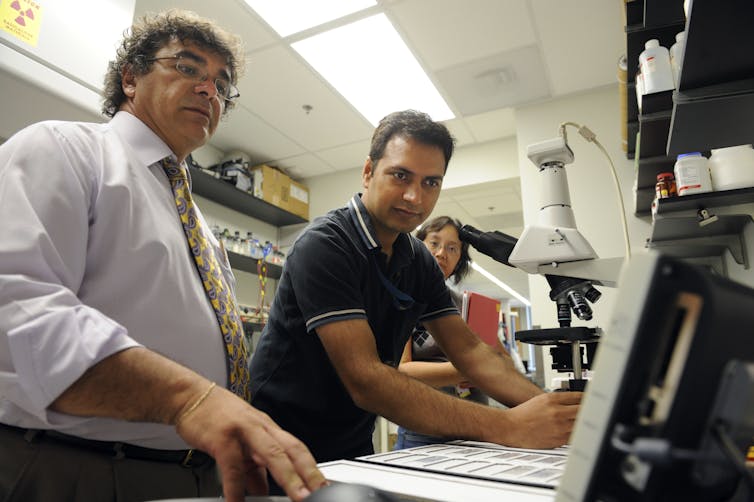Why Colorectal Cancer Awareness Month is really something to celebrate this year
March is the month to get the word out about screening for colorectal cancer. An important update: More people can get screened now, as the age for coverage for screening had been lowered to 45.

March is National Colorectal Cancer Awareness Month. I recognize that you’re not likely to throw a party to celebrate, since most of us are not comfortable talking about our butts and our bowel habits. However, there really is reason to talk about this disease, which kills over 50,000 people each year in the U.S.
As a research scientist and colorectal cancer advocate, I am particularly excited over two significant developments that have occurred recently. These could save lives.
First, in an effort to stem the growing numbers of younger adults who are diagnosed with the disease, a national panel has recommended lowering the age when screening should start to 45.
Second, federal law has changed the Medicare reimbursement to make sure that the cost of a screening colonoscopy is fully covered.
A deadly disease
Colorectal cancer remains a major source of cancer incidence and mortality worldwide. The American Cancer Society recently estimated that in 2021, there will be 149,500 new cases of colorectal cancer and 52,980 deaths in the U.S. alone. This places the disease fourth highest in terms of cancer incidence and second highest in mortality in the country. Only lung cancer claims more lives from cancer in the U.S. In addition, African Americans are more likely to be diagnosed with the disease and to die from it.
And yet, colorectal cancer is among the most preventable of cancers. Over the past three decades, timely screening and removal of precancerous lesions, called polyps, before they progress to cancer have contributed to sustained decreases in colorectal cancer incidence and mortality. So, progress is being made, but we have a ways to go.
In 2000, President Bill Clinton dedicated March as National Colorectal Cancer Awareness Month, indicating that “our most effective weapon in defeating colorectal cancer is early detection and treatment.” Each year, survivors, patients, medical providers, researchers and advocates collectively disseminate knowledge of colorectal cancer and its prevention to the general population, promoting awareness and action that will reduce the toll of this highly preventable disease.
Alarming trend in young adults
For quite some time, national guidelines have recommended that colorectal cancer screening begin at the age of 50, when risk of the disease starts to climb markedly. However, in recent years, researchers and physicians have observed that colorectal cancer is increasing in people under age 50. Screening has generally not been recommended for those under 50 unless major symptoms occur.
Those of us who study the disease do not fully understand the reasons behind this increase, but there is growing concern among doctors, researchers and, of course, patients and their families. This concern has led to reconsideration of screening guidelines by the federal panel that recommends them.
In October 2020, that panel – the United States Preventive Services Task Force – conducted a comprehensive and in-depth evaluation. It recommended that adults age 45-49 be screened for colorectal cancer. This brings the Task Force in line with what the American Cancer Society recommended in 2018.
The revised recommendations are formally in draft form now, but they should be finalized within the next several months. The Affordable Care Act mandates that colorectal cancer screening follow these guidelines, and that private insurers and Medicare cover approved screening tests with no co-payments.
Once the new guidelines are in place, young adults age 45-49, who are increasingly vulnerable to colorectal cancer, will become eligible for insurance that fully covers screening.
Getting rid of surprise payments
The second development concerns Medicare coverage of screening colonoscopies. While Medicare must cover colorectal cancer screening with no co-payments, a co-payment is charged if a polyp or other tissue is found and removed during a colonoscopy. The rationale for this has been that removal of tissue is considered a diagnostic, rather than a screening, procedure.
This distinction has led to patients being surprised with a co-payment they weren’t expecting. Thus, Medicare patients undergoing colonoscopy think that they are fully covered, only to be confused by being billed for a co-payment after the procedure had been carried out.
This has been deemed unacceptable by medical providers and public health advocates, who view removal of precancerous lesions to be an integral part of the screening process. In all, this situation, known as the Medicare loophole, has become a barrier to preventive colonoscopy in an older population that is at high risk of colorectal cancer.
After many years of advocacy and lobbying around this issue by organizations such as Fight Colorectal Cancer and the American Cancer Society Cancer Action Network, the loophole was finally closed in December 2020, when Congress passed, and President Trump signed, the Removing Barriers to Colorectal Cancer Screening Act of 2020. This act, part of the COVID-19 Economic Relief Bill, requires the waiving of coinsurance charges associated with colorectal cancer screening tests, regardless of whether tissue is removed during the test. It will be phased in during an eight-year period beginning in 2022.

The future of colorectal cancer screening
President Biden, in a proclamation to the nation on March 1, encouraged “all citizens, government agencies, private businesses, nonprofit organizations and other groups to join in activities that will increase awareness and prevention of colorectal cancer.” The new screening guidelines will help make that happen in the future.
A number of effective options for colorectal cancer screening were approved under the new guidelines. These include tests that look for the presence of blood or specific DNA biomarkers in fecal samples, and visualization tests that directly examine the inner lining of the colon and allow removal of tumors or precancerous lesions.
New technologies are emerging that should make screening easier and more effective. For example, liquid biopsies involve analysis of easily obtained bodily fluids, such as blood or urine. Doctors may soon to able to isolate and analyze cells or DNA that come from tumors and that are present within the bloodstream.
Also, molecules in urine may be potentially important as biomarkers for detection of colorectal lesions.
Though the utility of technologies such as these is still under study, it is clear that in the near future, we should witness the appearance of simpler, more accessible and more sensitive tests for colorectal cancer. It is important to note, however, that these noninvasive tests must be followed up by a colonoscopy if anything of concern is noted.
As National Colorectal Cancer Awareness Month reminds us, it is important for people of all ages to be aware of risk factors for colorectal cancer, of symptoms that may be indicative of the disease, and of strategies and guidelines for screening and prevention. Talk to your doctor and your insurance provider about colorectal cancer and its prevention. The more you know, the better.
Franklin G. Berger currently receives funding from the Centers for Disease Control and Prevention, and the General Assembly of the State of South Carolina. In the recent past, he has received funding from the National; Institutes of Health, The Duke Endowment, and the BlueCross BlueShield of South Carolina Foundation,
Read These Next
The Bible says little about Jesus’ childhood – but that didn’t stop medieval Christians from enjoyin
Legends about Jesus’ early years that circulated in medieval Europe often drew on apocryphal texts.
Data centers need electricity fast, but utilities need years to build power plants – who should pay?
How many data centers will be built – and how much electricity they’ll need – is uncertain. Being…
Sleep problems and depression can be a vicious cycle, especially during pregnancy − here’s why it’s
Inadequate sleep can have negative downstream effects on everyday cognitive functioning and mental health,…






